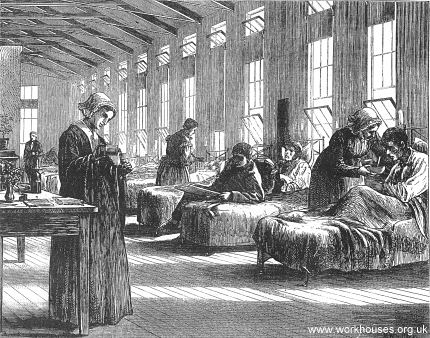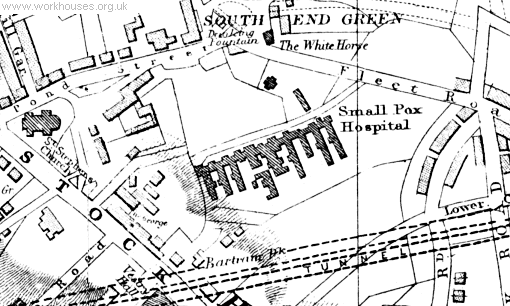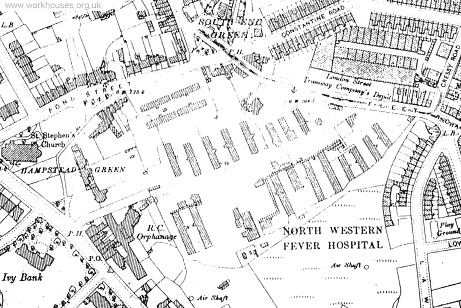The North Western Hospital, Hampstead
Hampstead was the location of first hospital to be opened by the Metropolitan Asylums Board which had been set up in 1867 to administer care for certain categories of the sick poor in metropolitan London. In 1868, the MAB paid £16,000 for the Hampstead site, which was situated at the south side of Fleet Road and known as 'Old Bartrams'. Here, and at two other sites at Stockwell and Homerton, it planned to build fever and smallpox hospitals. However, progress at Hampstead was delayed by local opposition to the scheme led by Sir Rowland Hill, pioneer of the postage stamp, who owned an adjacent property.
At the end of 1869, before the Stockwell and Homerton hospitals were ready, there was an outbreak of relapsing fever (an infection transmitted by ticks or lice) in the east of London. To deal with this, the MAB erected temporary huts in the grounds of the London Fever Hospital at Islington, and at the Hampstead site. The facilities at Hampstead, designed by the Manchester firm of Pennington & Bridgen, consisted of timber and metal huts providing 90 beds, with the possibility of being enlarged to 180 beds. The site, which opened on 25th January, 1870, was effectively England's first state hospital. It closed after the fever epidemic subsided in May 1870, but reopened in December 1870 when there was a serious outbreak smallpox in London. It was then soon filled with cases from all over the metropolis. For two months, it was the only isolation accommodation available to the MAB, and they were flooded with complaints from local Boards of Guardians about the appalling conditions in their overcrowded workhouses, chapels and vestry rooms.
In October, 1871, the Illustrated London News carried an article about the Hampstead Hospital.

Hampstead ward interior, 1871
On November 14th, 1871, the Hampstead ratepayers, led by local MP Lord George Hamilton, sent a deputation to make their feelings known to James Stansfeld, President of Local Government Board. The residents felt so strongly about the matter that they even offered to pay for the removal of the hospital to another location. The Times reported:
| THE HAMPSTEAD SMALLPOX HOSPITAL.— Yesterday afternoon a large and influential deputation attended at the office of the Local Government Board, Whitehall, for the purpose of "laying before Mr. Stansfeld, the President of the Board, the opinion of the inhabitants and owners of property in Hampstead, that the present site of the temporary smallpox hospital was unsuited for a permanent locality for contagious and infections diseases ; to request him not to give his sanction to a permanent building there, and to urge upon him to remove the present sheds as soon as it was prudent to do so." Lord George Hamilton, M.P., in introducing the deputation said he represented every class of the inhabitants of Hampstead and its immediate neighbourhood. Mr. Flowers, the chairman of the committee, explained the action which had been taken by the committee appointed at a public meeting of the inhabitants. They had in the first instance waited upon the Metropolitan Asylums Board, but failing to obtain any satisfaction from that body, they now came to head-quarters. The site of the present temporary hospital, which the Asylums Board intended to convert into a permanent hospital, was in every way unsuited lot the object. It was surrounded by houses, and in the immediate vicinity of a spot frequented in the summer time by hundreds of thousands of holyday people. There were a number of public and refreshment houses in the locality for the use of these holyday people, and were so used by large numbers of men, women, and children. In these houses the men engaged in bringing smallpox patients to the hospital, and in removing the bodies of those who had died, freely mixed with the visitors, and the disease had thus been caught by many persons. Again, in all the houses surrounding the hospital since it had been there, with the exception of three, cases of smallpox had occurred, and medical evidence showed that these cases had arisen from the hospital. | An infant school, with 100 children, was adjacent, and in Fleet-row close by, there had been 47 cases of smallpox in 78 houses. This was proof of one of two things — either that these cases had arisen from the proximity of the hospital, or else that the hospital was placed in a most unhealthy locality. He was prepared to prove that property in Hampstead had deteriorated to the extent of 100,000l. since the hospital had been there, and that the trade of the place had suffered to a corresponding extent. The committee had offered the Asylums Board to provide another site equal in extent, about a mile to the westward, which stood quite isolated, and to pay them in addition a sum of 3,000l. as the difference in the value of the land. They had asked the Asylums Board to appoint a committee of their body to confer with the local committee as to details. The offer, however, had been declined, and hence the present deputation. Mr. Pearse said he represented the tradesmen of Hampstead, and the continued passing through the streets of the town of ambulances with smallpox patients and hearses with the dead bodies of the victims of the disease had so alarmed the people that the trade of the place had greatly fallen off. Mr. Solly thought it was monstrous that after the Metropolitan Board of Works had spent a large sum in purchasing the Heath for the healthful recreation of the thousands of poor persons who resorted to it, another Board should step in and erect a pest house in the immediate locality. Dr. Holford said the present site of the hospital was in the hollow of a valley, and no competent medical man would have selected so unfavourable a site for an hospital. He could speak from practical experience among his patients as to the evils arising from the hospital. Mr. Marshall, the Rev. Mr. Mallett, Mr. Hadley and other members of the deputation having spoken, Mr. Stansfeld asked what it was the deputation required him to do. | Mr. Pearse: Not to sanction the erection of a permanent hospital, and to remove the sheds. Mr. Stansfeld said he did not propose to discuss the statements that had been made, though he might say be disagreed with many of them. It was but natural the deputation should take an exaggerated view of the matter. The fact was that the Asylums Board had purchased what they deemed a suitable site for an hospital, and he had no power to call upon that Board to make any sacrifice of its property to the injury of the great body of ratepayers whom it represented. If that Board, however, could be oonvinced of the advantage of changing the site of the hospital, then, indeed, the Local Government Board might facilitate the operation. He understood the local committee bad made no definite or practical proposal to the Asylums Board. Suppose the difficulty about the site was settled, then there was the cost of removal. Mr. Fellowes thought he spokethe sense of the deputation, and the inhabitants of Hampstead generally, when he assured the hon. gentlemen, that if the Asylums Board would remove the hospital to another more suitable spot they would bear that Board harmless from any expense whatever. Mr. Stansfeld said that was something practical, if made by any responsible body, but so definite a proposal had not been made to the Asylums Board. He should recommend the local committee to put this definite proposal in writing in a practical shape before the Asylums Board. That Board would then possibly feel justified in taking action upon it. That proposal could either be sent direct to the Board, or through him as President of the Local Government Board, if they preferred that course.. The deputation then retired, thanking Mr. Stansfeld for the courteous and patient manner in which he had received them. |
As a result of the residents' campaign, a parliamentary select committee investigated the operation of the hospital during the 1871 epidemic. Its report, published in 1875, found that patients had communicated with people over the hospital walls, and that relatives and ambulance men often stopped for refreshement at The George which still stands on Haverstock Hill. The committee concluded that the MAB had acted properly and that the problems were ones of individual carelessness and poor control of patients rather than to the presence of a smallpox hospital in the locality.
In 1873, it was decided that imbecile children then housed in the Board's asylums at Leavesden and Caterham should be accommodated separately. As the Hampstead site's smallpox wards were now empty, it was decide to place them there. Teachers were subsequently appointed in a then novel experiment in trying to educate "idiot" children. This arrangement ended in 1876 when the Hampstead accommodation was needed to deal with a new smallpox outbreak and the children were moved to a disused orphanage at Clapton. Plans were then made to replace the temporary buildings on the Hampstead site with permanent ones.
The new outbreak of smallpox and the re-admission of cases to Hampstead led to a resurgence of complaints from local residents, again led by Sir Rowland Hill. In January 1879, Hill and other Hampstead residents living near the Hospital were granted a legal injuction against the MAB who were required to "stop carrying on the hospital so as to cause a nuisance". Hill died in August 1879, but the cause was continued by his son Pearson Hill. Legal wrangling continued until 1883 until the MAB finally made an out of court agreement limiting the number of smallpox patients patients in the hospital at any one time to forty, and moving the hospital's entrance at Haverstock Hill to the opposite end of the site.
The hospital finally re-opened in 1882 as the North-Western Fever Hospital during a severe outbreak of scarlet fever in London. From soon after this time, the MAB began to treat the majority of the capital's smallpox patients on the hospital ships Atlas, Endymion and Castalia, moored on the Thames near Dartford.
As part of its settlement with the Hampstead ratepayers, the MAB purchased Sir Rowland Hill's former residence, Bartram House, and adjoining property at the north-west of the original site for £13,000.This provided the location for a further set of temporary ward huts, followed in 1892 by a third set at the north.
The site location and layout are shown on the 1888 and 1894 maps below.

North Western Hospital site, 1888.

North Western Hospital site, 1894.
In 1892, a permanent administration building was erected on the site of some of the original huts, followed in 1895 by some two-storey brick ward pavilions, and an isolation block on the original site. In 1897, a porter's lodge, nurses' home and ambulance station were added.
In 1930, control of the site passed to the London County Council. At this date there were still ten temporary iron and wooden ward huts on the site, together with a small cast-iron chapel.
In the first half of the twentieth century, the hospital was in great demand during outbreaks of diseases such as polio, and one ward was used by patients in iron lungs.
Following the inauguration of the National Health Service in 1948, the hospital joined the Royal Free Hospital Group and was renamed the Lawn Road or North-Western Branch of the Royal Free Hospital. As fever cases declined in Britain, the remaining infectious disease beds were transferred to Coppetts Wood Hospital and, from 1963, and the hospital was used for general cases. Throughout the 1960s, it achieved worldwide recognition as the place where the first kidney transplants were performed, and also the hospital which pioneered home dialysis. When the Royal Free was rebuilt in Hampstead, the land on which the North-Western Fever Hospital had stood was used, and the remaining parts of the old building were demolished in 1973.
Staff
Inmates
Records
- London Metropolitan Archives, 40 Northampton Road, London EC1R OHB. Has virtually all the surviving records for the Metropolitan Asylums Board and its instititutions. Search their catalogue at https://search.lma.gov.uk/.
Bibliography
- Ayers, Gwendoline, M. (1971) England's First State Hospitals and the Metropolitan Asylums Board (Wellcome Institute of the History of Medicine, London).
- Powell, Sir Allan (1930) The Metropolitan Asylums Board and its Work, 1867-1930. (MAB, London)
Links
- None.
Unless otherwise indicated, this page () is copyright Peter Higginbotham. Contents may not be reproduced without permission.


